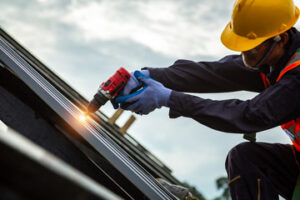Rochester NY Sealcoating protects asphalt from weather damage and prolongs the life of paved surfaces. It also makes the paved surface look richer in appearance and prevents oil, fuel, chemical substances and oxidation from penetrating and degrading the asphalt.

However, it is important to note that sealcoating does not repair pavement defects like cracks and holes. It is designed to prevent further damage rather than correct existing problems.
Sealcoating is a great way to extend the life of your asphalt surface. It protects the asphalt from moisture penetration, oxidation, chemical damage and traffic abrasion. It also creates a skid-resistant surface for wet weather, and it helps prevent dusting on gravel roads. Whether you have an asphalt parking lot, road or driveway, sealcoating will make it look like new and add curb appeal to your property.
Before seal coating can begin, the pavement must be cleaned and prepped. This includes repairing any holes or potholes, and power washing the pavement to remove any dirt or chemicals. It’s also important to treat any oil spots with an oxidation inhibitor and to fill any cracks prior to sealing the entire surface. The area to be sealed should then be blocked off with cones, barricades and/or safety tape to keep pedestrians and motorists away from the work area.
The pavement will then be broom swept to remove any loose material that would interfere with the bonding of the sealant to the asphalt. A professional pavement contractor will use brooms, sweepers and air blowers to remove debris from the area.
Once the pavement is ready, workers will start to mix the sealer. A barrel has a plastic lid with a hole that must be removed to access the mixing mechanism inside. The mixture must be thoroughly mixed before it is applied to the pavement. Each barrel will cover a specific amount of square footage, so the workers will have to move between barrels to ensure that all areas are covered evenly.
After the first coat is applied, it must dry completely before workers can apply a second coat. This can take up to 24 hours. If rain is forecast within this timeframe, the project will need to be postponed until the weather conditions are more favorable.
One of the most important things to remember when working with sealcoat is that it contains carcinogenic materials. Workers should be trained on how to use the equipment properly and avoid any contact with these substances. They will also need to use proper protective gear, such as respirators. This is especially true when working with coal tar emulsions, which are known to cause cancer and other health problems if they come into contact with the skin or lungs.
Application
Sealcoating is an important preventative maintenance procedure that protects the asphalt surface from gasoline, salt, water, ultraviolet rays and oil – substances which erode and damage paved surfaces. It also helps to maintain the flexibility of asphalt which in turn reduces abrasion and cracking. The addition of a sealcoat also increases the surface friction properties of a paved roadway. Regular sealcoating can save you money in the long run, as the protective coating prevents the need for costly pavement replacement.
Before the application of sealcoat, any potholes or pavement deficits should be repaired using either crack filler or patching material. Once the repairs are completed, the surface should be blown free of dust, debris and dirt. This is done with a power blower. It is recommended that this step be completed a day or two before your scheduled sealcoating date to allow the asphalt to dry completely.
It is important to select a day for the sealcoat application that has clear skies and warm temperatures. If the surface temperature is too low, the slurry will not bond well to the blacktop. Likewise, if the weather is too hot, the sealant may set before it has had a chance to cure properly.
A high quality sealcoat is comprised of refined tar, solvents, sand and additives. The mix design is determined by the manufacturer to achieve the desired performance characteristics. Prior to applying any sealcoating, it is critical to read and understand the product literature and material safety data sheets for both the base and additives.
Sealcoat is commonly supplied as concentrates that need to be mixed with the proper amount of water, sand and additives for proper application consistency according to the manufacturer’s recommendation. Ensure that all of the ingredients are of the highest quality and that they are compatible with each other to achieve the best results.
During the application process, it is crucial to keep pedestrians and vehicles away from the sealcoat area until the slurry has had time to cure. This allows the surface to fully adhere to the blacktop and provides a safe surface for both pedestrians and vehicles. Pedestrians should be notified of the work in advance and directed to other access points on your property, such as manhole covers or driveway gates. It is also important to protect any manhole covers, drains and utility access points from the sealcoating material as it dries.
Curing
Sealcoating requires a few days to dry and cure properly. The ideal conditions for this process are warm temperatures, no precipitation, and clear skies. The presence of sunlight is also important, as it both creates and renews heat. This speeds up the drying process significantly. Humidity is another factor that affects how quickly the material dries. If humidity levels are too high, they can double or even triple the amount of time it takes for sealcoating to dry and cure.
It is recommended that the application of sealcoat is done from spring through fall, as these are the best weather conditions for this project. It is also possible to use a special product that is designed to be applied in a wider range of temperatures, but this usually comes at the cost of a shorter curing time. It is also important to be sure that the surface being sealed is fully clean and free of debris before applying the sealcoat.
Depending on the type of sealcoat that is used, it may take a few hours for the material to dry and cure. Once this happens, it is safe to drive on the newly-sealed asphalt paving surface. However, it is recommended that drivers wait another 24 hours for the sealcoat to be completely dry before driving on it again.
The grit that is added to most sealcoat mixtures helps the material hold up well against the pressure of automobile traffic, preventing it from wearing away as quickly as the underlying asphalt. In addition, the sand in the mix helps to provide traction on the road and give it a more uniform textured appearance.
If the sand in the sealcoat mix is too coarse, it can cause the sealcoat to prematurely wear off, exposing the underlying asphalt to damage and degradation. For this reason, it is important to choose sand that is within the specified sieve size range for the particular sealcoat formulation.
It is also important to note that Refined Coal Tar (RTS) sealcoats can give off vapors that can burn the skin, and it is therefore necessary to protect the body from contact with this material before and after application. Some companies offer specially-designed clothing for this purpose.
Maintenance
Seal coating is one of the most cost-effective pavement maintenance measures that you can take to extend the life of your asphalt driveway or parking lot. It can make the surface look brand new and fill in small cracks. It also helps to reduce the amount of maintenance that is needed over time by reducing wear and tear. By scheduling regular seal coating services, you can avoid costly repairs and maintain the pristine appearance of your pavement for much longer than you would without it.
A properly done seal coat is durable and resistant to both abrasion and chemical attack. It will also provide a skid-resistant and dust-free surface. It will also help to prolong the life of the underlying asphalt by keeping moisture out. In addition, the sealcoat will help to protect the asphalt from oil, fuel and other chemicals that can degrade the surface. It will also help to prevent the asphalt from becoming brittle due to the constant pressure of vehicle traffic.
Unlike many other types of businesses, sealcoating is relatively easy to start and requires only minimal equipment. However, it is important to have business insurance coverage that is tailored specifically to the needs of a sealcoating company. This type of coverage will help to protect the business owner in the event that their equipment is stolen or damaged and will also provide financial support if any legal action arises.
It is also important to know how to properly care for a sealcoat after it has been applied. If the sealcoat is left unattended, it can easily become damaged and disbond from exposure to sun and water. In order to avoid this, it is important to keep the area covered with tarps or other protective coverings until the sealcoat has a chance to dry completely.
A sealcoat should be reapplied every 2-3 years in order to keep it looking its best and performing at its maximum capacity. A professional contractor should be able to advise the client as to the proper schedule for resealing based on the specific conditions of the property. For example, a parking lot that is exposed to heavy truck traffic will require more frequent resealing than a residential driveway.

